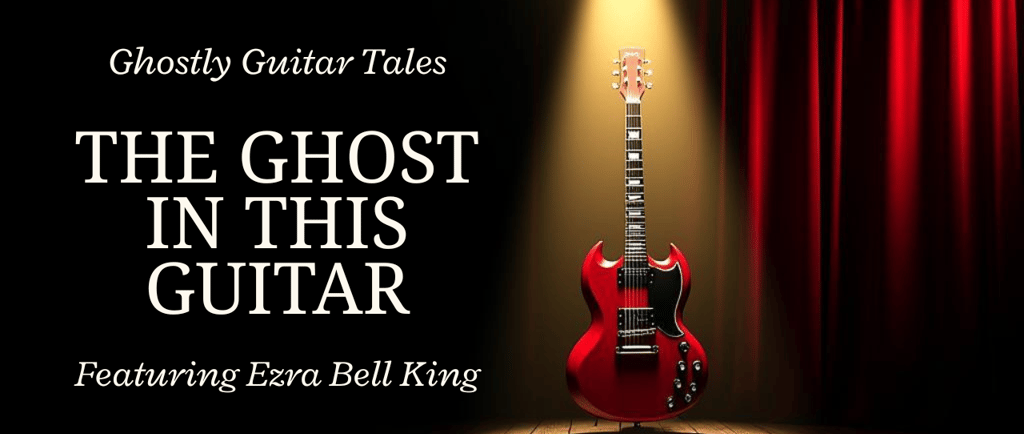
The Ghost in the Machine
The Ghost in the Machine: How an Instrument Became a Character
Steve D
10/7/20254 min read


The Ghost in the Machine: How an Instrument Became a Character
We often think of a musician’s instrument as a tool, an inanimate object used to create sound. But for the true artist, it’s something far more profound. It’s a confidant, a diary, a repository of every emotion ever poured into it. For Ezra Bell King, his cherry red SG isn't just a guitar; it's a vessel for memory, a character in the story of his life, and, as he so hauntingly posits in one of his most poignant songs, it’s permanently, beautifully haunted.
The song "The Ghost in This Guitar" is a masterclass in metaphor. It takes the universal experience of being haunted by memory and makes it tangible, visceral, and achingly specific. Let's explore how an object of wood and wire became one of the most compelling characters in Ezra's musical narrative.
The Guitar as a Sacred Object
Before we can understand the ghost, we must understand the vessel. The cherry red SG isn't a random prop; it's an extension of Ezra himself. Its vibrant color speaks to a soul that refuses to be dimmed, a defiant joy that contrasts with the often-muted tones of his clothing and the weathered texture of his voice. It was, as told in "Dust and Diamonds," "bought with pennies and with pride," a hard-won prize that represents a dream clung to through years of struggle.
This history imbues the instrument with its own spirit. Every scratch is a memory of a specific gig; every worn spot on the fretboard is a testament to ten thousand practiced hours. It has been with him in empty bars and, now, on roaring stages. It has absorbed the sweat of his brow and the weight of his silence. It is, in every sense, a living archive of his journey.
Deconstructing the Haunting: Who is the Ghost?
The genius of the song is that the "ghost" is never explicitly defined. This ambiguity is its strength, allowing every listener to project their own specters onto the music.
Is it a Lost Love? The most immediate interpretation. The lyrics "This wood and wire remembers your touch" and "I see your shadow in the stage lights' glow" powerfully evoke the presence of a specific person. The guitar becomes a relic of that relationship, its very fibers imprinted with the memory of a love that once was. Playing it isn't just making music; it's conducting a séance, conjuring a presence that is both painful and comforting.
Is it a Former Self? Perhaps the ghost is the man Ezra used to be. The younger, more hopeful, or more naive artist who first held this guitar. The one who hadn't yet accumulated the scars and wisdom he sings about in "Rust & Gold." The ghost could be the echo of dreams that have since been tempered by reality, a bittersweet reminder of the road already traveled.
Is it the Music Itself? On a more metaphysical level, the ghost could be the spirit of music—the muse that possesses him when he plays. It's an external force that speaks through him, using the guitar as its medium. This ghost isn't something to be exorcised, but something to be channeled.
The song’s power lies in its ability to encompass all these interpretations at once. The ghost is all of these things and more.
The Psychology of a Haunted Object
Why do we attach such profound meaning to objects? It's a well-documented psychological phenomenon. A soldier's helmet, a grandmother's wedding ring, a child's first teddy bear—these items are more than their physical form; they are vessels of emotional residue.
Our senses are powerfully tied to memory. The scent of a perfume can instantly transport you back decades. The feel of a certain fabric can bring a loved one vividly to mind. For Ezra, the guitar is the ultimate sensory trigger. The feel of the wood grain under his fingers, the specific resonance of the strings, the very posture of holding it—all of these are direct pathways to the past. The guitar isn't haunted by a supernatural entity; it's haunted by the sheer weight of the lived experience it represents. The ghost is memory itself, and the guitar is its home.
The Live Experience: A Shared Séance
Hearing "The Ghost in This Guitar" on a recording is one thing. Experiencing it live is another. In a live setting, the song transforms. The stage lights dim, leaving Ezra in a solitary spotlight. The crowd, once roaring, falls into a reverent hush. As he sings, you can hear a pin drop. It’s in this silence that the ghost becomes real for everyone in the room.
You’re not just watching a man sing about his memories; you’re being invited to confront your own. The song becomes a collective act of remembrance. When Ezra’s voice cracks on the line, "I can't exorcise this love, it's buried in the grain," it’s a moment of profound, shared vulnerability. He isn't trying to rid himself of the ghost; he's learning to live with it, to make music with it. And in doing so, he gives the audience permission to do the same with their own hauntings.
Conclusion: Not an Exorcism, but a Duet
"The Ghost in This Guitar" is often mistaken for a sad song. It’s not. It’s a song about integration. It’s about the realization that our past—the loves we've lost, the people we used to be, the pain we've endured—is not a separate thing to be locked away. It is woven into the very fabric of who we are now.
The ghost isn't a malevolent force to be expelled. By the end of the song, it’s clear the ghost is the source of the music. The pain, the memory, the love—it’s all fuel for the art. Ezra isn't playing despite the ghost; he's playing because of it. He has learned the most valuable lesson any artist or any human can learn: don't fight your ghosts. Invite them to sing along. The resulting harmony may be the most beautiful sound you'll ever make.
Connect
Stay updated with Ezra's latest music.
Follow
Contact
ezra@ezrabellking.com
© 2025 Ezra Bell King. All Rights Reserved
Legal